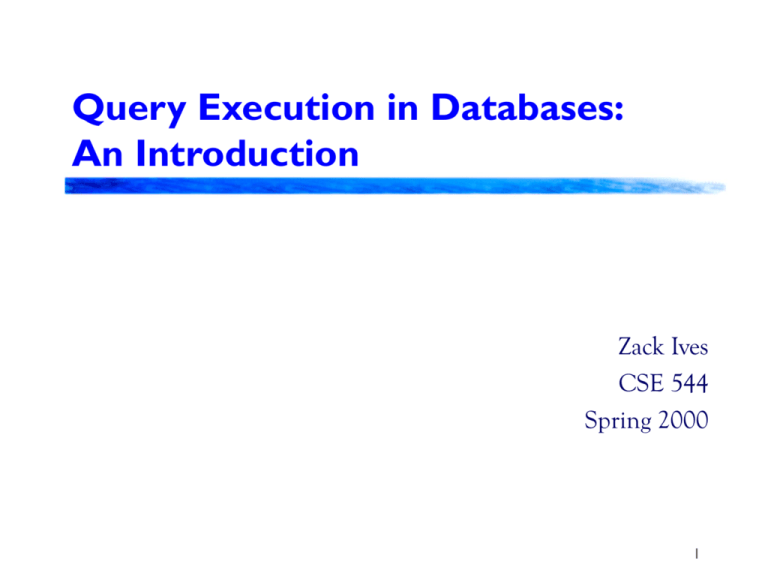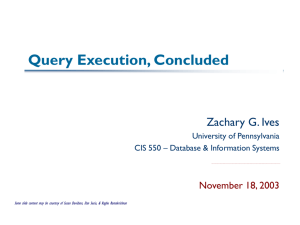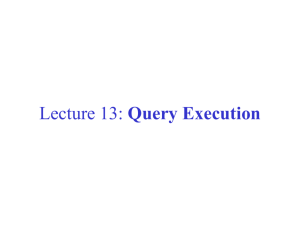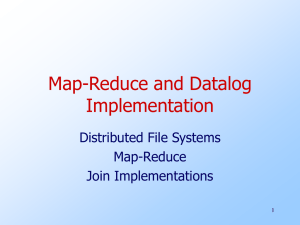Query Execution Techniques
advertisement

Query Execution in Databases: An Introduction Zack Ives CSE 544 Spring 2000 1 Role of Query Execution A runtime interpreter … or, the systems part of DBMS Inputs: Query execution plan from optimizer Data from source relations Indices Data Query Outputs: Query result data Updated data distribution statistics (sometimes) Indices Execution Results 2 Outline Overview Basic principles Primitive relational operators Aggregation and other advanced operators Querying XML Trends in Execution Wrap-up: execution issues 3 Query Plans Data-flow graph of relational algebra operators Typically: determined by optimizer Trends: adaptivity for distributed data SELECT * FROM PressRel p, Clients C WHERE p.Symbol = c.Symbol AND c.Client = ‘Atkins’ AND c.Symbol IN (SELECT CoSymbol FROM Northwest) Join Symbol = Northwest.CoSymbol Join Project PressRel.Symbol = Clients.Symbol CoSymbol Select Client = “Atkins” Scan Scan Scan PressRel Clients Northwest 4 Execution Strategy Issues Granularity & parallelism: Join Pipelining vs. blocking Threads Materialization Control flow: Iterator/top-down Data-driven/bottom-up Threads? Symbol = Northwest.CoSymbol Join Project PressRel.Symbol = Clients.Symbol CoSymbol Select Client = “Atkins” Scan Scan Scan PressRel Clients Northwest 5 Data-Driven Execution Schedule via leaves Join (generally parallel or distributed system) Leaves feed data “up” tree; may need to buffer Good for slow sources or parallel/distributed In typical system, can be inefficient Symbol = Northwest.CoSymbol Join Project PressRel.Symbol = Clients.Symbol CoSymbol Select Client = “Atkins” Scan Scan Scan PressRel Clients Northwest 6 The Iterator Model Execution begins at root Join open, next, close Propagate calls to children Symbol = Northwest.CoSymbol May call multiple child nexts Efficient scheduling & resource usage Join Project PressRel.Symbol = Clients.Symbol CoSymbol Select If slow sources, children communicate from separate threads Client = “Atkins” Scan Scan Scan PressRel Clients Northwest 7 Execution Has a Cost Different execution plans produce same results at different cost – optimizer estimates these It must search for low-cost query execution plan Statistics: Cardinalities Histograms (estimate selectivities) I/O vs. computation costs Pipelining vs. blocking operators Time-to-first-tuple vs. completion time 8 Basic Principles Many DB operations require reading tuples, tuple vs. previous tuples, or tuples vs. tuples in another table Techniques generally used: Iteration: for/while loop comparing with all tuples on disk Buffered I/O: buffer manager with page replacement Index: if comparison of attribute that’s indexed, look up matches in index & return those Sort: iteration against presorted data (interesting orders) Hash: build hash table of the tuple list, probe the hash table Must be able to support larger-than-memory data 9 Reducing I/O Costs with Buffering Read a page/block at a time Should look familiar to OS people! Tuple Reads/Writes Use a page replacement strategy: LRU (not as good as you might think) MRU (good for one-time sequential scans) Clock, etc. Note that we have more knowledge than OS to predict paging behavior Buffer Mgr DBMIN (min # pages, local policy) Double-buffering, striping common 10 Two-Way External Sorting Pass 1: Read a page, sort it, write it. only one buffer page is used Pass 2, 3, …, etc.: three buffer pages used. INPUT 1 OUTPUT INPUT 2 Disk Main memory buffers Disk Two-Way External Merge Sort Each pass we read + write each page in file. N pages in the file => the number of passes log2 N 1 Total cost is: 3,4 6,2 9,4 8,7 5,6 3,4 2,6 4,9 7,8 5,6 4,7 8,9 2,3 4,6 3,1 1,3 Input file PASS 0 1-page runs PASS 1 2 2 1,3 5,6 2 2-page runs PASS 2 2,3 2 N log 2 N 1 Idea: Divide and conquer: sort subfiles and merge 4,4 6,7 8,9 1,2 3,5 6 4-page runs PASS 3 1,2 2,3 3,4 4,5 6,6 7,8 9 8-page runs General External Merge Sort How can we utilize more than 3 buffer pages? To sort a file with N pages using B buffer pages: Pass 0: use B buffer pages. Produce N / Bsorted runs of B pages each. Pass 2, …, etc.: merge B-1 runs. INPUT 1 ... INPUT 2 ... OUTPUT ... INPUT B-1 Disk B Main memory buffers Disk Cost of External Merge Sort Number of passes: 1 log N / B B1 Cost = 2N * (# of passes) With 5 buffer pages, to sort 108 page file: Pass 0: 108 / 5 = 22 sorted runs of 5 pages each (last run is only 3 pages) Pass 1: 22 / 4 = 6 sorted runs of 20 pages each (last run is only 8 pages) Pass 2: 2 sorted runs, 80 pages and 28 pages Pass 3: Sorted file of 108 pages Hashing A familiar idea: Requires “good” hash function (may depend on data) Distribute across buckets Often multiple items with same key Types of hash tables: Static Extendible (requires directory to buckets; can split) Linear (two levels, rotate through + split; bad with skew) 15 Basic Operators Select Project Join Various implementations Handling of larger-than-memory sources Semi-join 16 Basic Operators: Select If unsorted & no index, check against predicate: Read tuple While tuple doesn’t meet predicate Read tuple Return tuple Sorted data: can stop after particular value encountered Indexed data: apply predicate to index, if possible If predicate is: conjunction: may use indexes and/or scanning loop above (may need to sort/hash to compute intersection) disjunction: may use union of index results, or scanning loop 17 Basic Operators: Project Simple scanning method often used if no index: Read tuple While more tuples Output specified attributes Read tuple Duplicate removal may be necessary Partition output into separate files by bucket, do duplicate removal on those May need to use recursion If have many duplicates, sorting may be better Can sometimes do index-only scan, if projected attributes are all indexed 18 Basic Operators: Join — Nested-Loops Requires two nested loops: For each tuple in outer relation For each tuple in inner, compare If match on join attribute, output Join outer Block nested loops join: read & match page at a time What if join attributes are indexed? inner Index nested-loops join Results have order of outer relation Very simple to implement Inefficient if size of inner relation > memory (keep swapping pages); requires sequential search for match 19 (Sort-)Merge Join Requires data sorted by join attributes Use an external sort (as previously described), unless data is already ordered Merge and join the files, reading sequentially a block at a time Maintain two file pointers; advance pointer that’s pointing at guaranteed non-matches Preserves sorted order of “outer” relation Allows joins based on inequalities (non-equijoins) Very efficient for presorted data Not pipelined unless data is presorted 20 Hash-Based Joins Allows partial pipelining of operations with equality comparisons (e.g. equijoin, union) Sort-based operations block, but allow range and inequality comparisons Hash joins usually done with static number of hash buckets Generally have fairly long chains at each bucket Require a mechanism for handling large datasets 21 Hash Join Read entire inner relationtuple into hash table (join attributes as key) For each tuple from outer, look up in hash table & join tuple tuple tuple Very efficient, very good for databases tuple Not fully pipelined Supports equijoins only Delay-sensitive 22 t Running out of Memory Two possible strategies: Overflow prevention (prevent from happening) Overflow resolution (handle overflow when it occurs) GRACE hash overflow resolution: split into groups of buckets, run recursively: Write each bucket to separate file Finish reading inner, swapping tuples to appropriate files Read outer, swapping tuples to overflow files matching those from inner Recursively GRACE hash join matching outer & inner overflow files 23 Hybrid Hash Join Overflow A “lazy” version of the GRACE hash: When memory overflows, swap a subset of the tables Continue reading inner relation and building table (sending tuples to buckets on disk as necessary) Read outer, joining with buckets in memory or swapping to disk as appropriate Join the corresponding overflow files, using recursion 24 Pipelined Hash Join (a.k.a. Double-Pipelined Join, XJoin, Hash Ripple Join) tuple tuple tuple Two hash tables As a tuple comes in, add to the appropriate side & join with opposite table Fully pipelined, datadriven Needs more memory 25 Overflow Resolution in the DPJoin Based on the ideas of hybrid hash overflow Requires a bunch of ugly bookkeeping! Need to mark tuples depending on state of opposite bucket - this lets us know whether they need to be joined later Three proposed strategies: Tukwila’s “left flush” – “get rid” of one of the hash tables Tukwila’s “symmetric” – get rid of one of the hash buckets (both tables) XJoin’s method – get rid of biggest bucket; during delays, start joining what was overflowed 26 The Semi-Join/Dependent Join Take attributes from left and feed to the right source as input/filter Important in data integration Simple method: for each tuple from left send to right source get data back, join More complex: JoinA.x = B.y A x B Hash “cache” of attributes & mappings Don’t send attribute already seen Bloom joins (use bit-vectors to reduce traffic) 27 Join Comparison 28 Aggregation + Duplicate Removal Duplicate removal equivalent to agg function that returns first of duplicate tuples Min, Max, Avg, Sum, Count over GROUP BY Iterative approach: while key attribute(s) same: Read tuples from child Update value based on field(s) of interest Some systems can do this via indices Merge approach Hash approach Same techniques usable for difference, union 29 What about XML? XML query languages like XML-QL choose graph nodes to operate on via regular path expressions of edges to follow: WHERE <db><lab> <name>$n</> <_*.city>$c</> </> ELEMENT_AS $l </> IN “myfile.xml” is equivalent to path expressions: We want to find tuples of ($l, $n, $c) values Later we’ll do relational-like operations on these tuples (e.g. join, select) 30 Example XML Document 31 XML Data Graph 32 Binding Graph Nodes to Variables l n baselab #2 lab2 #6 c__ #4 #8 33 XML Operators New operators: XML construction: Create element (add tags around data) Add attribute(s) to element (similar to join) Nest element under other element (similar to join) Path expression evaluation X-scan 34 X-Scan: “Scan” for Streaming XML We often re-read XML from net on every query Data integration, data exchange, reading from Web Previous systems: Store XML on disk, then index & query Cannot amortize storage costs X-scan works on streaming XML data Read & parse Track nodes by ID Index XML graph structure Evaluate path expressions to select nodes 35 Computing Regular Path Expressions Create finite state machines for path expressions 36 More State Machines … 37 X-Scan works on Graphs The state machines work on trees – what about IDREFs? Need to save the document so we can revisit nodes Keep track of every ID Build an “index” of the XML document’s structure; add real edges for every subelement and IDREF When IDREF encountered, see if ID is known If so, dereference and follow it Otherwise, parse and index until we get to it, then process the newly indexed data 38 Recent Work in Execution XML query processors for data integration Tukwila, Niagara (Wisconsin), Lore, MIX “Adaptive” query processing – smarter execution Handling of exceptions (Tukwila) Rescheduling of operations while delays occur (XJoin, query scrambling, Bouganim’s multi-fragment execution) Prioritization of tuples (WHIRL) Rate-directed tuple flow (Eddies) Partial results (Niagara) “Continuous” queries (CQ, NiagraCQ) 39 Where’s Execution Headed? Adaptive scheduling of operations – not purely iterator or data-driven Robust – as in distributed systems, exploit replicas, handle failures Able to show and update partial/tentative results – operators not “fully” blocking any more More interactive and responsive – many non-batchoriented applications More complex data models – handle XML efficiently 40 Leading into Our Next Topic: Execution Issues for the Optimizer Goal: minimize I/O costs! “Interesting orders” Existing indices How much memory do I have and need? Selectivity estimates Inner relation vs. outer relation Am I doing an equijoin or some other join? Is pipelining important? Good estimates of access costs? 41








